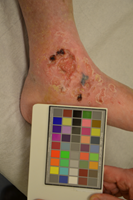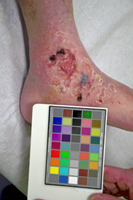- 2024
- Spectral Imaging Experts' Day
- Upcoming ICC Meetings
- 2023
- London Meeting Invited Speaker session
- 2022
- HDR Experts' Day
- 2020
- ICC DevCon 2020
- Munich, 10-11 February
- 2019
- ICC Color Experts' Day, Bressanone
- 2018
- ICC Color Symposium Hong Kong, 22 October
- Grand Rapids, MI, 30-31 May
- ICC DevCon 2018
- Munich, 25-26 February
- 2017
- Ryerson Toronto Graphic Arts Day, 13 October
- Toronto, 11-12 October
- Prague Graphic Arts Experts' Day, 29 June
- Prague, 27-28 June
- Tokyo, 19-20 April
Best Practices for Digital Color Photography in Medicine
Mission statement:
Collect industry best practices in the field of digital photography and write a guidance document which can be used by the medical industry to minimize the color errors created during the digital color camera image capture process.
Scope:
This guidance document will apply for a range of digital cameras (from cellphone cameras to scientific grade cameras) and lighting conditions. Recommendations will also be made for camera setup and color correction in post processing.
Content:
- Introduction and background
- Factors that can contribute to color errors
- Recommended light conditions
- Recommended camera setup
- Use of reference color charts
- Color correction in post-processing
- Recommendations on color management
Document distribution:
- ICC publication
- Journal article
- Collaboration with other organizations (e.g. American Telemedicine Association)
Participants
- Yves Vander Haeghen, University of Ghent Hospital
- Stein Olav Skrovseth, Norwegian Centre for Telemedicine
- Elizabeth Krupinski, Arizona State University
- Aldo Badano, FDA
- Phil Green, ICC
Project coordinator: John Penczek NIST/Univ. of Colorado
Publication:
Go to Medical Imaging Working Group main page.
Meetings
See the Medical Imaging Working Group main page for details of upcoming meetings.
Calibration examples
Images on the left below are uncalibrated, calibrated images are on the right.


Image 1. Ulcer. The image on the left is as shot with camera in full automatic mode, but the original image is still very yellowish. The image on the right has been calibrated to a D65 display white point as described in the guidelines. Courtesy of the University Hospital Ghent, Belgium.
Image 2. Ulcer. Similar problem as for Image 1: white-balance produced a green tinge. Courtesy of Dr. Sven Van Poucke, Ziekenhuis Oost-Limburg, Belgium.
Image 3. Animal experiment, using a very simple color chart. Courtesy of Dr. Sven Van Poucke, Ziekenhuis Oost-Limburg, Belgium.
Images 4 and 5. Vitiligo. Original images (left) were taken only seconds apart using full automatic settings of the camera, producing very different images. Courtesy of the University Hospital Ghent, Belgium.
Image 6. Pigmented lesion. Over-exposed image, masking a lot of specular reflection. Calibration recovers this partly. Courtesy of the University Hospital Ghent, Belgium.
Image 7. Ulcer. Camera was in full automatic mode, but the original image is still very yellowish partly due to typical hospital wall colors. Courtesy of the University Hospital Ghent, Belgium.

